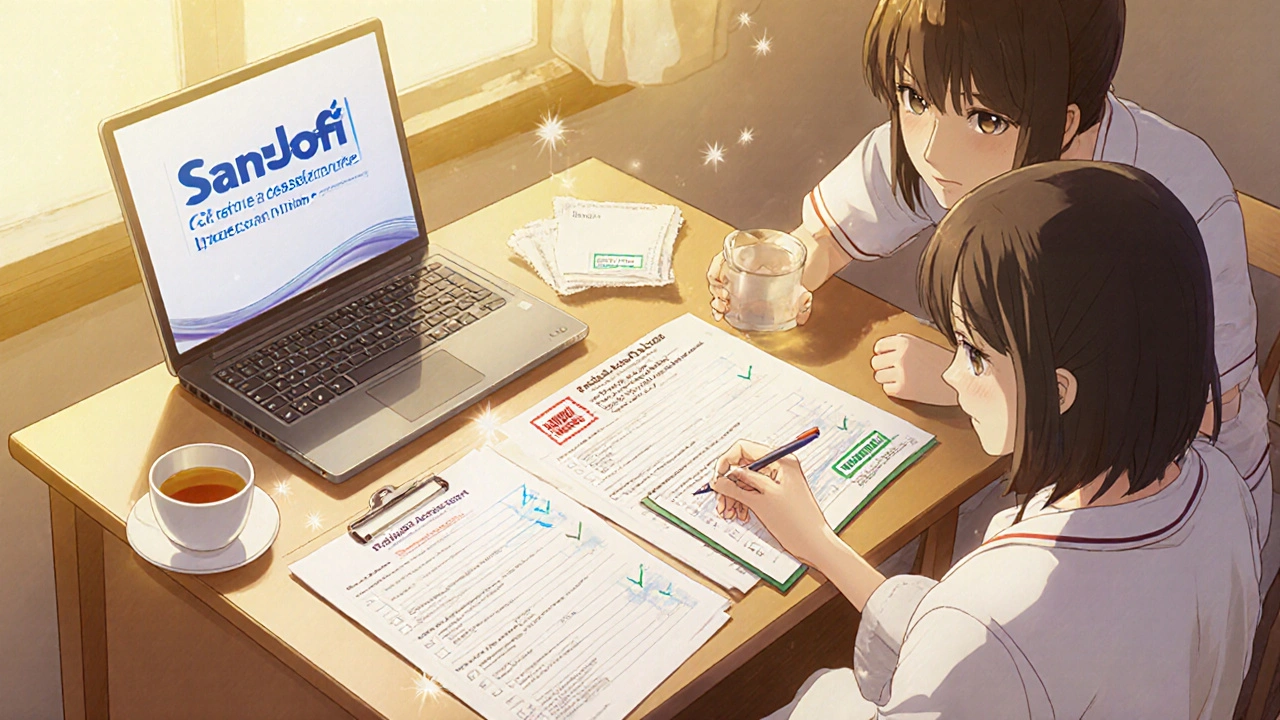Teriflunomide Cost Calculator
Estimate your potential savings with Teriflunomide assistance programs
Living with Teriflunomide can feel like a roller‑coaster - the medication helps control your multiple sclerosis (MS), but the cost, side‑effects, and daily routine can leave you searching for a safety net. This guide pulls together the most reliable sources of help, from manufacturer assistance to community support, so you can stay on track and keep your confidence high.
What is Teriflunomide?
Teriflunomide is an oral disease‑modifying therapy (DMT) approved for treating relapsing forms of multiple sclerosis. It works by inhibiting the enzyme dihydroorotate dehydrogenase, which reduces the proliferation of activated T and B lymphocytes that drive MS inflammation. First approved by the U.S. Food and Drug Administration (FDA) in 2012, it is marketed under the brand name Aubagio and produced by Sanofi.
Why Patients Need Support
Even though Teriflunomide is taken once daily, patients often encounter three main hurdles:
- Cost: The monthly price can exceed $3,000 before insurance. Out‑of‑pocket expenses can be a barrier for many.
- Side Effects: Common issues include hair thinning, liver enzyme elevation, and gastrointestinal upset. Some users experience rare, severe reactions like Stevens‑Johnson syndrome.
- Adherence & Lifestyle: Remembering a daily pill, scheduling regular blood tests, and coping with fatigue can strain motivation.
Addressing each obstacle usually involves a mix of financial assistance, medical monitoring, and emotional encouragement.
Financial Assistance Options
Below is a quick‑look comparison of the most widely used programs for Teriflunomide users. Choose the one that fits your insurance status, income level, and location.
| Program | Eligibility | Benefits | How to Apply |
|---|---|---|---|
| Sanofi Patient Assistance Program (PAP) | U.S. residents, uninsured or under‑insured, income ≤ 500% of Federal Poverty Level | Free medication, optional copayment assistance for those with partial coverage | Complete online application, upload prescription and proof of income |
| Multiple Sclerosis Society Financial Aid | Members with documented financial hardship, any insurance status | One‑time grants up to $5,000 toward medication costs | Submit an online form plus supporting documents; decisions in 2‑4 weeks |
| Pharmacy Discount Card (e.g., GoodRx) | All patients, no income verification | Average 30‑45% off retail price; printable coupon | Search for Teriflunomide on website, print coupon, present at pharmacy |
| Private Insurance Prior Authorization | Patients with commercial or government insurance | Coverage after clinician submits prior‑auth form; may include co‑pay assistance | Physician contacts insurer; patient follows up for approval status |
How to Enroll in the Sanofi Patient Assistance Program
Sanofi is the global pharmaceutical company that manufactures Teriflunomide (Aubagio). Their PAP is often the most generous source of free medication. Follow these steps:
- Visit the official Sanofi patient assistance webpage (search “Sanofi Aubagio PAP” to find the current URL).
- Download the PDF application or start the online form.
- Gather the required documents: a recent prescription, a copy of your insurance card (if any), and proof of income (pay stubs, tax return, or letter from a social services agency).
- Have your prescribing neurologist sign the healthcare provider section. Most clinics will fax the signed form directly to Sanofi.
- Submit the completed package via the secure portal or mail it to the address listed on the form.
- Within 7‑10 business days, Sanofi will notify you of approval and ship the medication to your pharmacy.
Tip: Keep a copy of the submission receipt and a note of the tracking number. If you don’t hear back within two weeks, call the PAP helpline and reference your application ID.

Emotional and Peer Support Resources
Managing MS isn’t just about pills. Connecting with others who understand the daily grind can boost adherence and mental health.
Multiple Sclerosis Society is a nonprofit organization that offers educational material, webinars, and local support groups for people living with MS. Check their “Find a Support Group” tool for meetings in Adelaide or virtual gatherings worldwide.
Online forums such as PatientsLikeMe is a patient‑driven network where users share treatment experiences and quality‑of‑life scores. Search the “Teriflunomide” tag to see real‑world side‑effect reports and coping strategies.
Social media groups on Facebook and Reddit (e.g., r/MultipleSclerosis) also host weekly “Ask a Neurologist” sessions. Engaging in these communities can provide quick answers to dosage questions and moral support when flare‑ups happen.
Monitoring Side Effects Safely
Because Teriflunomide can affect liver enzymes, your neurologist will order baseline labs and follow‑up tests every 3 months. Here’s a simple checklist to keep you on top of monitoring:
- Mark the dates of each lab draw in your phone calendar.
- Log any new symptoms (e.g., persistent nausea, jaundice, hair loss) in a notebook.
- Bring the lab results to every neurology visit and discuss any abnormal values.
- If the liver enzyme (ALT/AST) rises above 3 × the upper limit of normal, the doctor may pause the drug for at least 4 weeks and consider an accelerated elimination procedure using cholestyramine.
- Women who are pregnant or plan to conceive must stop Teriflunomide and undergo a rapid wash‑out; the FDA mandates a teriflunomide plasma level < 0.02 mg/L before pregnancy attempts.
Having a dedicated caregiver or family member review this checklist can catch issues early and reduce anxiety.
Practical Tips to Stay Motivated
Adherence is easier when the routine feels natural. Try these low‑effort habits:
- Morning cue: Keep the pill bottle next to your toothbrush.
- Weekly pill organizer: Fill it on Sunday evenings; if a slot is empty, you know you missed a dose.
- Reward system: After a month of perfect adherence, treat yourself to a movie night or a new book.
- Mobile reminders: Use a free medication reminder app that also logs side‑effects.
- Share progress: Tell a trusted friend or partner each week; accountability makes you less likely to skip.
When you feel discouraged, remember that many patients report a 30‑40% reduction in relapse rate after staying on Teriflunomide for a full year. That statistic alone can be a powerful motivator.

When to Seek Professional Help
If you experience any of the following, contact your neurologist or primary care provider immediately:
- Severe abdominal pain or persistent vomiting.
- Yellowing of the skin or eyes (signs of liver trouble).
- Unexplained bruising or bleeding.
- New or worsening neurological symptoms, such as vision loss or difficulty walking.
- Signs of infection (fever, chills) while on the drug.
Having a pre‑filled “Urgent Symptoms” sheet on the fridge can speed up communication with your care team.
Key Takeaways
- Teriflunomide is an effective oral DMT for relapsing MS but comes with cost and side‑effect challenges.
- Financial help ranges from Sanofi’s patient assistance program to pharmacy discount cards and MS Society grants.
- Regular lab monitoring, a strong support network, and simple daily habits improve adherence.
- Never ignore severe symptoms; early medical intervention prevents complications.
- Connecting with peers and using structured assistance can turn a solitary journey into a community‑backed experience.
Frequently Asked Questions
Can I get Teriflunomide for free if I have insurance?
Often yes. Your neurologist can submit a prior‑authorization request to your insurer. If the insurer denies coverage, you can combine the partial benefits with the Sanofi Patient Assistance Program to cover the remaining cost.
How often do I need blood tests while on Teriflunomide?
Baseline labs are taken before starting the drug, then every 12 weeks (approximately three months) for the first year. After that, many doctors shift to six‑month intervals if liver enzymes remain stable.
Is there a pregnancy‑related safety plan for Teriflunomide?
Yes. Women must stop the medication, start an accelerated elimination protocol (cholestyramine or activated charcoal), and confirm plasma levels are below 0.02 mg/L before trying to conceive. Discuss the plan with your neurologist well in advance.
Where can I find local MS support groups in Adelaide?
The Australian MS Society’s website has a “Find a Group” tool that lists monthly meetings at the Adelaide Community Health Centre and virtual meetings via Zoom. You can also call their helpline for the most up‑to‑date schedule.
What should I do if I miss a dose?
Take the missed pill as soon as you remember, unless it’s almost time for the next dose. In that case, skip the missed one and continue with your regular schedule - don’t double‑dose.


Janet Morales
October 18, 2025 AT 18:05I’ve seen dozens of patients rave about the Sanofi PAP, but let’s be real-most of that hype is a smoke‑screen. The fine print often hides eligibility hoops that can trip anyone up, especially if you’re juggling insurance and a full‑time job. While the money side might look shiny, the emotional toll of endless paperwork can be brutal. Bottom line: weigh the paperwork fatigue against the potential savings before you dive in.
Albert Fernàndez Chacón
October 18, 2025 AT 19:03In clinical practice, the cost barrier is mitigated by prior‑auth pipelines that insurance companies run, and the Sanofi program slots in as a safety net when those pipelines stall. Patients who pair the PAP with GoodRx coupons often see a 30‑45% reduction in out‑of‑pocket spend. It’s also worth noting that regular liver function monitoring-part of the standard DMT protocol-doesn’t have to be a hassle if you set reminders on your phone. So, think of the assistance programs as complementary pieces of a larger adherence strategy.
Drew Waggoner
October 18, 2025 AT 20:01The side‑effect profile can feel like a relentless storm, especially the hair thinning that some describe as “slowly disappearing.” If your labs start flashing red, it’s not just a number-your body is screaming for attention.
Mike Hamilton
October 18, 2025 AT 21:00Sometimes the therapeutic journey feels like a cross‑cultural exchange, where each lab result is a new language to decipher. I’ve often wondered if we’re merely translating symptoms into data points or if there’s a deeper human story behind each test. The doc’s notes can read like a poem, imperfectly scribed, yet full of meaning. It’s okay to feel a bit lost-therapeu tic paths rarely follow straight lines.
Liberty Moneybomb
October 18, 2025 AT 21:58Did you ever notice how the big pharma giants push these “patient assistance” schemes just when they raise the list price again? It’s like a magician’s trick-now you see the discount, now you see the hidden surcharge. The Sanofi PAP may look generous, but it’s also a data‑harvesting tool that tracks who needs help and feeds it back to marketing. Keep your eyes peeled; the sponsorship isn’t always as benevolent as it seems.
kendra mukhia
October 18, 2025 AT 22:56My extensive research, which includes reading every FDA advisory notice and diving into the latest conference abstracts, confirms that the most effective adherence boost comes from pairing the PAP with a structured reminder system. Anything less is just wishful thinking. If you’re not logging each dose in a mobile app, you’re practically leaving the medication on the table for fate.
Bethany Torkelson
October 18, 2025 AT 23:55Don’t underestimate the power of a simple pill organizer; positioning the bottle by your toothbrush can cut missed doses in half.
Grace Hada
October 19, 2025 AT 00:53Philosophically, consistency is a virtue; practically, a weekly tracker enforces it.
alex montana
October 19, 2025 AT 01:51Wow!!!...??!! Remember, the liver labs every three months are not optional-skip them and you risk serious complications-so set that alarm!!
Sarah Hanson
October 19, 2025 AT 02:50I wholeheartedly apprciate the comprehensive guide you have compiled for patients navigating Teriflunomide therapy.
Nhasala Joshi
October 19, 2025 AT 03:48Listen, the “free medication” narrative is a classic control‑matrix, and the pharma lobby pulls strings behind the curtains 🎭. When they say “no cost to you,” they’re really talking about “cost to the system” and that trickles down to us. The PAP is just a Trojan horse, delivering data while pretending to be charity 🌐. Stay vigilant, question the motives, and remember-knowledge is the real antidote 🧠.
Brian Van Horne
October 19, 2025 AT 04:46From a pragmatic standpoint, integrating a medication reminder app with your calendar can create a seamless workflow-no more missed doses, no more scrambling. Moreover, sharing your experience in a patient forum adds a layer of communal accountability that can boost morale. In short, blend technology with community support for optimal adherence.
Norman Adams
October 19, 2025 AT 05:45Oh, because obviously the best way to solve a complex pharmacoeconomic issue is to tweet a meme and hope the insurance companies feel sorry for you. Sure, let’s all ignore the rigorous prior‑auth process and rely on goodwill-makes perfect sense.
Margaret pope
October 19, 2025 AT 06:43It’s helpful to keep a simple checklist on the fridge; write down the next lab date and tick it off when done. This visual cue can reduce anxiety and keep you on track.
Karla Johnson
October 19, 2025 AT 07:41When I first started Teriflunomide, I was overwhelmed by the cascade of instructions, financial forms, and monitoring schedules that accompanied the prescription. The first thing I did was map out every requirement on a whiteboard, breaking down the PAP application into bite‑size steps. I then set up calendar alerts for each lab draw, labeling them with colors that correspond to the urgency of the test. In parallel, I reached out to the MS Society and secured a grant that covered a portion of the copay, which turned out to be a lifesaver during the initial months. To stay honest with myself, I kept a daily journal noting any side effects, no matter how minor they seemed, because patterns can emerge only after weeks of observation. This habit also gave my neurologist concrete data during quarterly appointments, making the conversations more productive. I discovered that the pharmacy discount card, while not eliminating the cost entirely, shaved off roughly a third of the retail price, which added up to significant savings over a year. Additionally, I enrolled a close family member as my medication buddy; we text each other each morning confirming the dose was taken, creating a built‑in accountability loop. When the paperwork for the Sanofi program seemed endless, I called their helpline, and after a brief hold, a representative walked me through the last missing document, which turned out to be a simple pay‑stub. That personal touch reminded me that behind the corporate veneer there are actual people willing to help. I also joined an online Reddit thread dedicated to Aubagio users, where we share tips on managing the occasional nausea and discuss the latest research findings. The community’s collective wisdom has been invaluable, especially when a new study suggested a modified dosing schedule for certain patients. Over time, I’ve learned that adherence is less about willpower and more about building a robust support ecosystem. By combining financial assistance, clinical monitoring, social support, and personal organization, I’ve managed to stay on therapy with minimal disruption. Ultimately, the journey taught me that proactive planning turns a daunting medication regimen into a manageable part of daily life.